Today’s Stat’s
Date: 11/08/2014
Starting Location: Santiago, Chile
Ending Location: Santiago Chile
Today’s Events: Detailed Below
Life here in Santiago…
After a shower, and a quick update to the ‘Blog, I finally headed to bed at 11 PM local time. Santiago is two hours earlier than EST, or 5 hours earlier than PST. So, let me first admit that when I think about the time zones of South America, I assumed that the West Coast of South America was roughly in sync with the West Coast of the US. Now that I’m here, I can see how I missed this critical detail.
How may of these little things about the planet, about world travel, and about other countries do we all have a misunderstanding of? I suspect that I’ll quickly learn that a good amount of what I thought I knew about South America is wrong.
My temporary home
Now that I’m in Chile, I’m staying at a little Suites hotel, which is clean, and reasonable in every way. The Tour Company (Compass Expeditions) took care of booking the room for the extra two days that I’ve asked for. The tour itself includes one night in this hotel, but I’ve added two more days so that we can go out and enjoy a bit of Santiago. We’re planning a bus tour later today, and a wine tour on Sunday.
We’ve booked the wine tour in advance, and expect it to include a BBQ, and a hike to XXX falls.
Being a morning person in Santiago, Chile
I’m someone that is used to getting up early, and starting my day. I routinely get up at 4AM, and am buying my morning coffee at 5AM, after which I make breakfast, and then start my day, usually by 6AM PST. I realize that I am a bit unusual, and not everyone gets up at this time, but I’m certainly not alone, and the US tends to prepare to get to work early in the AM.
Well, in places like Santiago, things run on a bit of a different clock. At our hotel, you cannot even get a cup of coffee until 8:30 AM. So, when we try to get up and prepare for the wine tour tomorrow, we’ll need to make our way out into the neighborhoods and buy a coffee from an entrepreneur who is up at the crack of dawn (let’s call that 7AM).
I suspect that we’ll adjust and deal with this just fine.
Getting to know my fellow travelers
Since I’m traveling on this tour as a single, I tried to manage the budget by sharing a room with someone. While I cannot be 100% sure yet, it seems that most of the tour is filled with pairs of folks, with only two of us being singles. As a result, I’ve been paired up with Jim, who is a 71 year old guy from the Chicago area, now living in Arizona, where he has a 2nd house. Jim has been on a number of these tours before, so I may look to him for some good advice. He and I have been connected by email for about a month now, but we actually had a chance to speak on Sunday, just 5 days ago.
I’m looking forward to meeting Jim, and expect to see him tomorrow (Nov 8th) in the middle of the afternoon.
Learning the language
Some of you have suggested that I use my iPhone and things like Google Translate and other technologies to overcome the language barrier. Well, as a good friend said to me just a few days ago… There’s an app for that. At the time, he was referring to finding an app that describes things to do in Ushuaia, but the statement is universally true. And of course, being someone that prides themselves on being able to identify, select, choose (and even pay millions of dollars for) technology, I have already installed a few of these apps.
The jury is still out on how well they might actually work, when I’m trying to make my point quickly. Being an American, I hope that I don’t fall into the trap of trying to make my point and overcome the language barrier by simply talking slower or louder. We’ve all seen people trying to do this, and of course, it not only does not work, but it shows these people from other cultures how arrogant we can be. I’m committed to trying to embrace their culture and language, and if that means I’ll need to add an extra dose of humility to my morning breakfast, then so be it.
Of course, I’ll keep the app handy, and use it whenever it makes sense…
Santiago is a very nice city
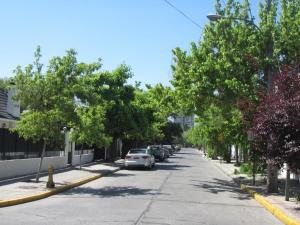
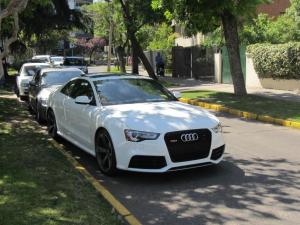 This morning, while waiting for Jim to arrive, I had a chance to wander around and get lost a bit. I found the city to be quite nice, filled with quiet, tree-lined streets, with the occasional RS5 parked on the road. Yep, that’s right, there was a White RS5 on the streets of Santiago.
This morning, while waiting for Jim to arrive, I had a chance to wander around and get lost a bit. I found the city to be quite nice, filled with quiet, tree-lined streets, with the occasional RS5 parked on the road. Yep, that’s right, there was a White RS5 on the streets of Santiago.
The wine tour – Booking it!
This morning, I spoke to the two clerks at the front desk and they were very good about helping me find a wine tour that would suit Jim and I. We first found a private tour, for $400 USD each, which sounded really nice, but was way beyond our budget. Having already spent over $12K for this trip, I needed to find a way to do things on the cheap, and begin enjoying the money that I’ve already spent. So,(I’m rationalizing here…) I took the cheap option, which will cost Jim and I about $65 USD each, for a 7 hour tour.
In many parts of the world, spending this amount of money on a wine tour would seem quite extravagant, but I am not on a Round The World (RTW) tour, where I’m pinching every penny. I’m on the vacation of a lifetime, so the idea of spending another $65 seems like nothing at all to me. And so it goes…
A little sight seeing
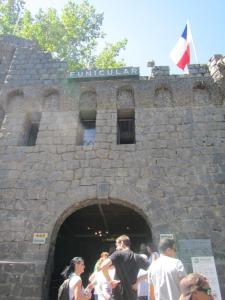 Visiting the Cerro San Cristóbal, located at the top of the Cerro hill was fun, but I’m not sure it will draw too many people to Santiago. it all starts out with a castle that’s not a castle, but is in fact just a facade to cover the place where the ticket booth is. Between the castle and the virgin Mary is a bit hill. So, what exactly is this place?
Visiting the Cerro San Cristóbal, located at the top of the Cerro hill was fun, but I’m not sure it will draw too many people to Santiago. it all starts out with a castle that’s not a castle, but is in fact just a facade to cover the place where the ticket booth is. Between the castle and the virgin Mary is a bit hill. So, what exactly is this place?
In essence, Cerro San Cristobal is a statue of the Virgin Mary, located at the top of a hill that is about 2000′ or so in elevation. While the statue may not be that much fun, but if you want to get to the top using Rapid Transit, you can take the funicular to get to the top. The Funicular is often called a tram, or a trolly, but it’s actually something quite a bit different.
The funicular is, under it’s pale green skin, simply a trolly car, which is run by cables. But, it seems that the entire process of getting the cars to the top relies on gravity, rather than some other system.
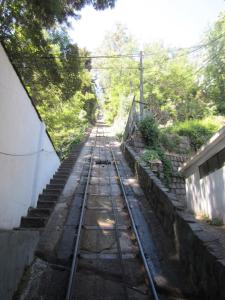 Imagine there are two cables that are the length of the run from the top to the bottom. The run is perfectly straight, has no turns, and is of a constant grade. One cable is located between the railroad tracks center right, while the other cable is located between the tracks center left.
Imagine there are two cables that are the length of the run from the top to the bottom. The run is perfectly straight, has no turns, and is of a constant grade. One cable is located between the railroad tracks center right, while the other cable is located between the tracks center left.
At any point in time, the pulley system is either pulling in cable, or letting it out for either of the two cars. In fact, it’s always doing both at the same time. Now, I mentioned that there are two cars, but only one track. So, at exactly the mid-point, there is a separation of the tracks, so that one car goes to the right, and the other goes to the left. The process is quite simple, but a bit unnerving the first time you see it done.
Here is a video that shows the whole thing happening.
Anyway, we took the funicular to the midpoint, and exited, so that we could visit the zoo, which is strangely, and precariously built on this steep hillside. Roaming the walkways of the zoo means to have to deal with thousands of steps. For me, this is the cloud that had a silver lining. Over the course of the day, I was able to log more than 20,000 steps on my FitBit. So, while all the walking was a bit of pain in the Santiago sun, I’m glad to have taken in such an energetic day.
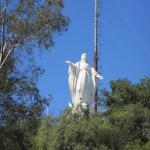
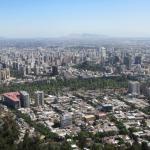
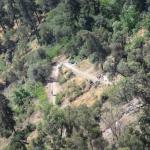 I’ve included some pictures from the funicular and from a variety of places where all tourists take pictures. We’ve got a shot of the old Virgin Mary, a shot from the landing at the midpoint, and another shot from the top, looking down at the trails that are on the side of the mountain, and which you can use to make your way up the mountain. I mean, not everybody is a lazy good-for-nothing tourist that will take the funicular. Some of these folks ride their bikes up.
I’ve included some pictures from the funicular and from a variety of places where all tourists take pictures. We’ve got a shot of the old Virgin Mary, a shot from the landing at the midpoint, and another shot from the top, looking down at the trails that are on the side of the mountain, and which you can use to make your way up the mountain. I mean, not everybody is a lazy good-for-nothing tourist that will take the funicular. Some of these folks ride their bikes up.
So, what comes next?
it’s about 10PM, and it’s time to get some rest. Tomorrow is wine tasting day!